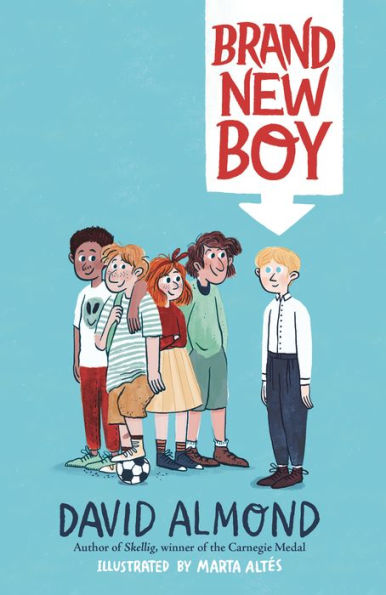Brand New Boy explores the “humanity” of manufactured humans through the eyes of curious middle-school students.
Brand New Boy by David Almond, with pictures by Marta Altés. Candlewick, 2022, 304 pages.

Reading Level: Middle Grades, ages 10-12
Recommended for: ages 10-14
What to make of the New Kid?
Daniel and his mates at Darwin Avenue Primary Academy are intrigued when the headmistress, Mrs. Hoolihan, announces a new boy at school. Her excitement indicates more than an ordinary transfer student, and indeed, George is peculiar. He doesn’t have a last name, doesn’t appear to have a family, and doesn’t respond to normal kid interaction. But on the second day his ear falls off, and that’s when Daniel, Maxie, Peter, and Louise realize the truth: George is a robot. He appears to be under the control of a handful of adults who keep constant notes and careful control. Mrs. Hoolihan keeps chattering about how fortunate they are to participate in this great experiment. But to the kids, it’s just not right. The grownups hover over George, but do they love him? Is he capable of being loved? Or worthy?
What makes a real boy?
The story is told from a juvenile point of view, so we don’t get any details of how George is constructed. The details we do get don’t make much sense. But it isn’t a really a science fiction story; it’s a what-makes-a-human? story. For their opening exercises every day the children sing “All Things Bright and Beautiful” with its chorus, “The Lord God made them all” (this is Newcastle, England, where they still do that kind of thing). The song makes a, possibly ironic, connection with the name of the school, and with idea of creatures being made by something other than the Lord God. Is George the next stage of evolution? Should there even be such a thing? The answer is ambiguous, if there is an answer, but the questions are worth asking.
Heavy thoughts, but it’s not a heavy book. The part where the kids divide George among themselves may come off as creepy, but the humorous illustrations and observations make it a fun read that doesn’t require deep reflection. Like most books by David Almond, it’s hard to classify.
Considerations:
- The word “hell,” as in “what the hell,” occurs about five or six times.
- Daniel lives with his Mam (the Newcastle version of Mum) but no dad. “What’s that these days?” observes one of the more unsympathetic characters. “Perfectly normal, is it not?” Sadly too true.
Overall Rating: 4
- Worldview/moral value: 3.75
- Artistic/literary value: 4.5
Read more about our ratings here.
Also at Redeemed Reader:
- Reviews: How to Make a Friend is a tongue-in-cheek picture book about constructing a pal. Your Pal Fred is another robot, this one programmed for kindness in a tough, dystopian world.
- Reviews: New Kid and Class Act look at the problems of adjusting to a different school.
- Reflection: The Pinocchio story has some similarities to Brand New Boy. Simonetta Carr discussed the Italian origins of the story and its relevance to Christian readers in a podcast interview years ago. Unfortunately the podcast has been lost, but the Afterword is interesting, too. Most of us only know the Disney version—is the book better? (There’s a lot of pushback in the comments!)
We are participants in the Amazon LLC affiliate program; purchases you make through affiliate links like the one below may earn us a commission. Read more here.
Stay Up to Date!
Get the information you need to make wise choices about books for your children and teens.
Our weekly newsletter includes our latest reviews, related links from around the web, a featured book list, book trivia, and more. We never sell your information. You may unsubscribe at any time.
Support our writers and help keep Redeemed Reader ad-free by joining the Redeemed Reader Fellowship.
Stay Up to Date!
Get the information you need to make wise choices about books for your children and teens.
Our weekly newsletter includes our latest reviews, related links from around the web, a featured book list, book trivia, and more. We never sell your information. You may unsubscribe at any time.
We'd love to hear from you!
Our comments are now limited to our members (both Silver and Golden Key). Members, you just need to log in with your normal log-in credentials!
Not a member yet? You can join the Silver Key ($2.99/month) for a free 2-week trial. Cancel at any time. Find out more about membership here.
2 Comments
Leave a Comment
You must be logged in to post a comment.




This is a curious set-the-stage review that leaves me wondering: does this book have a plot line to speak of?
I also wonder if “a fun read” aimed at older kids is ever “just that,” rather than a candy coating for … ?
Maybe this book is a slyly subversive critique of adults turning children into objects of manipulation for their own virtue signaling — which is doing so much to undermine legitimate adult authority these days — well that might be worth a read.
ALison–Thanks for these thought-provoking questions! The underlying message of a book depends on who’s reading it, and what they bring to it. The author certainly has a worldview which will come out with more or less subtlety. Often, I think, the author gets an idea and goes to work on it, without understanding what it all “means” until well into the project. The reader will have another perspective to bring, and may–actually, likely will–draw a meaning that diverges from the author’s. That’s an indicator of art, I think: that a work is open to multiple interpretations. Brand New Kid does have a plot line, albeit a simple one. But often the simplest plots are open to the widest range of meaning.